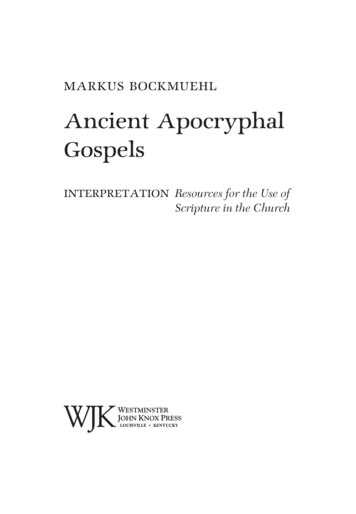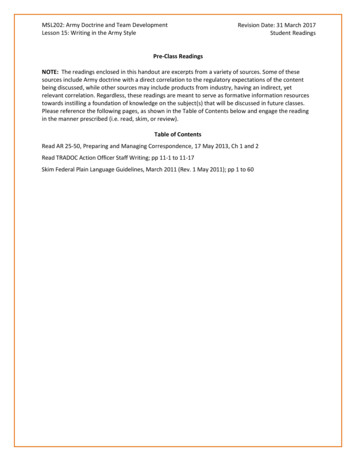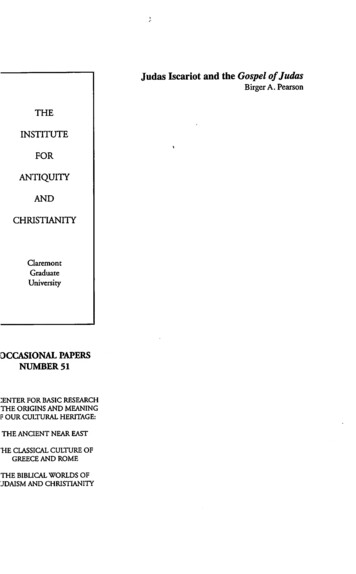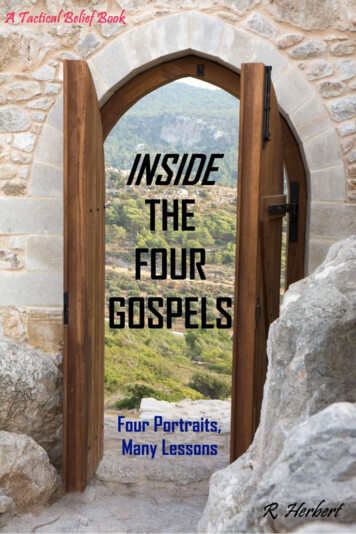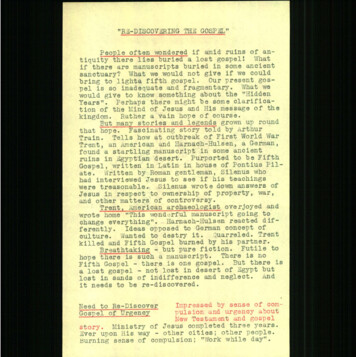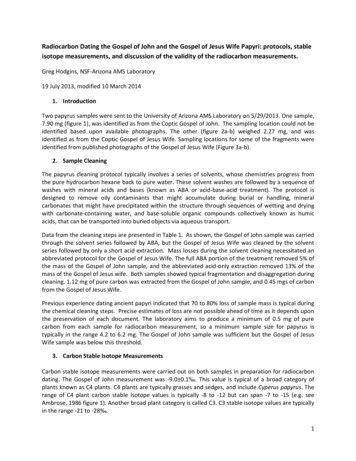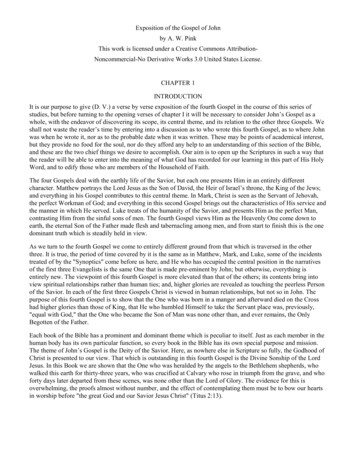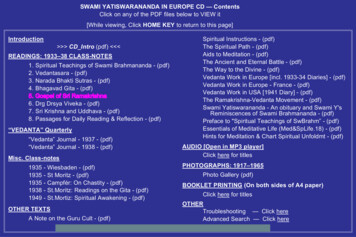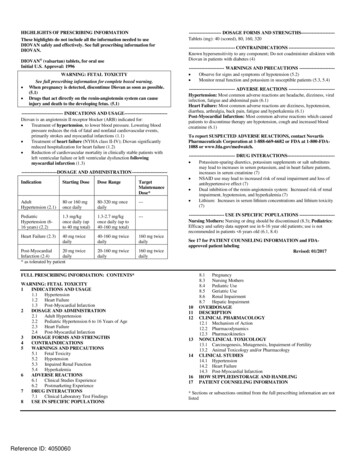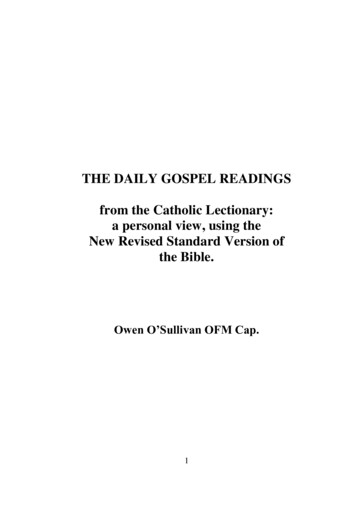
Transcription
THE DAILY GOSPEL READINGSfrom the Catholic Lectionary:a personal view, using theNew Revised Standard Version ofthe Bible.Owen O’Sullivan OFM Cap.1
Owen O’Sullivan OFM Cap., 2015.2
INTRODUCTIONI began work on this project about 2006 andcompleted it in 2015. My purpose in embarking on itwas to have something that I could use in speakingto people about the daily Gospel readings from theLectionary at Mass. It covers those readings fromMonday to Saturday of each week of the liturgicalyear, beginning with Monday of the first week ofAdvent, and ending on Saturday of Week 34 ofOrdinary Time.As the title indicates, it is a personal view. I havehad no formal training in scripture other than thegeneral seminary course of now more than forty-fiveyears ago. Professional scripture scholars may raisean eyebrow – or blow a fuse – from time to time ifthey ever read it. But that is unlikely, since I havecompiled it for my personal use with no thought ofpublishing it.My hope is that it may help, in those churcheswhich I serve, to bridge the large gap that existsbetween the findings of the biblical scholars and theunderstanding of the ordinary man or woman in thepew. If it helps that process in some way, I will feelwell rewarded.Owen O‟Sullivan OFM Cap.Capuchin FriaryChurch St.Dublin 73
ACKNOWLEDGEMENTSScripture texts are mostly from the New RevisedStandard Version of the Bible, Catholic edition,copyright 1989 by the Division of ChristianEducation of the National Council of Churches ofChrist in the U.S.A.I also used: Biblia-Catholic.net, a US translation available on theinternet;The Douai Bible, William Egan & Co., Cork,Ireland, 1953;The Jerusalem Bible, standard edition, Darton,Longman and Todd, London, 1966.I consulted: Dufour, Xavier-Léon, Dictionary of BiblicalTheology, Chapman, London, 1961.Fuller, Reginald C. (general editor), A New CatholicCommentary on Holy Scripture, Nelson, London,1975, abbreviated in the text as NCCHS.McKenzie, John L., Dictionary of the Bible,Geoffrey Chapman, London, 1976.4
Volume 1:from Monday of the first week of Adventto Saturday of Week 6 in Ordinary Time.5
Volume 2:from Ash Wednesdayto Saturday of Week 5 of Easter.6
Volume 3:from Monday of Week 6 of Easterto Saturday of Week 18 in Ordinary Time.7
Volume 4:from Monday of Week 19to Saturday of Week 34 in Ordinary Time.8
Advent, Week 1MondayMatthew 8.5-13 Jesus heals a centurion’s servant5. When he entered Capernaum, a centurion came tohim, appealing to him6. and saying, „Lord, my servant is lying at homeparalyzed, in terrible distress.‟7. And he said to him, „I will come and cure him.‟8. The centurion answered, „Lord, I am not worthyto have you come under my roof; but only speak theword, and my servant will be healed.9. For I also am a man under authority, with soldiersunder me; and I say to one, “Go,” and he goes, andto another, “Come,” and he comes, and to my slave,“Do this,” and the slave does it.‟10. When Jesus heard him, he was amazed and saidto those who followed him, „Truly I tell you, in noone in Israel have I found such faith.11. I tell you, many will come from east and westand will eat with Abraham and Isaac and Jacob inthe kingdom of heaven,The Lectionary reading stops at v.11.12. while the heirs of the kingdom will be throwninto the outer darkness, where there will be weepingand gnashing of teeth.‟13. And to the centurion Jesus said, „Go; let it bedone for you according to your faith.‟ And theservant was healed in that hour.9
There is a passage parallel to this in Luke 7.1-10,and it is like the story of the cure of the nobleman‟sson in John 4.46-53.V.5: The scene opens in Capernaum, Jesus‟ „owntown‟ (Matthew 4.13; 9.1), where he began histeaching, and worked signs and wonders, but whichlater provoked him to curse it (Matthew 11.23) forits unbelief.V.6: There is great humility here on the part of thecenturion, coupled with manliness and strength ofcharacter. He was taking a risk, exposing himself tothe possibility of a humiliating rebuff. Withoutgrovelling, he makes known his need and asks forhelp. And it‟s not for himself, but for his servant.V.7: Jesus‟ response is simple and direct; he agreesto do it. That sounds easy but it took courage andmore. The Romans were the occupying power, andthey were cruel; to kill one of their subject peoplemeant nothing to them. Here was Jesus showinghimself willing to help one of their leaders – in otherwords, he was collaborating with the occupiers. Hecould have said, „We Jews owe you Romansnothing; you have no claim on us. Go back to whereyou came from, and take your boyfriend (pais) withyou.‟ Had he done so, the crowd would have beendelighted, probably applauded, and revelled in thehumiliation and dismissal of a representative of theirenemy. But then Jesus would not have been Jesus.By agreeing to help a Roman, he put himself at risk10
from the Zealots who made a point of targeting theRomans in their soft under-belly, the localcollaborators.Vv.8-9: But the centurion, speaking from hisexperience as an army officer, wants to save Jesusthe trouble of going to his house; all he need do isgive an order and it will happen.Vv.10-12: Jesus was amazed at his faith andcontrasted it to the weak faith of his own people. Ifhis own people, to whom he came first, do notaccept him, others will. This is a key theme ofMatthew, who was a Jew writing for Jews. Jesusgoes on to say that many will come from east andwest, and will eat – an earthy image - in the kingdomof heaven. This is one of many universalistperspectives in Jesus. He is not imprisoned bynarrow loyalties. But it grieved him that his ownpeople – „the heirs of the kingdom‟ - were soresistant.The Lectionary stops the story at v.11, cutting itoff in mid-sentence. To have stopped at v.10 wouldhave focused on the punch-line. To have continueduntil v.13 would have completed the story, butstopping at v.11 seems to have nothing to commendit. Was it simply a mistake?V.13: The centurion‟s servant was healed in thathour, „according to your faith.‟ There is no healing11
without faith. Healing is not waving a magic wand;it requires human cooperation. Miracles are intendedto give witness to who Jesus is and what his missionis. They require trust in him and a readiness to let goof one‟s self. Matthew makes the same point inMatthew 9.2, 22 and 28 in the miracle stories whichfollow this.An anonymous article on the internet has this tosay about the passage: The usual word for a slave or servant wasdoulos. But the word used in this passage ispais, perhaps because it produces a play onwords with the Greek word for paralysis. At thetime, pais could mean one of five things: a son or boy;a servant who ruled other servants and cared forhis master's children;a servant who was his master‟s male lover;the junior partner in a homosexual relationship;an attractive young male.Instead of pais, Luke, in 7.1-10, uses the termentimos doulos which means honoured slave.This would be a common expression for a slavewho had an especially close relationship withhis master. We can exclude all but two(explanation to follow) potential definitions:either this was a slave who managed thehousehold, taking care of his master‟s servants12
and children, or he was in a romantic or sexualrelationship with his master.The head of a Roman household would, likely,treat his slave as sexual property. Until late inthe Roman Empire, the adult male had the rightto maim or kill his slaves on a whim. Even afterlaws to protect slaves were enacted, they werelargely ignored. At no point in Roman historywere laws enacted to prevent the rape, sodomy,or sexual exploitation of a patriarch's humanproperty; such actions were always within hislegal authority. Both Jesus' audience and theearly Roman and Jewish hearers to whom theGospels were first preached would have knownthat.In the ancient world, homosexual armies werecommonplace. The elite fighting forces of theGreeks, Romans, Spartans, Cretans, andBoeotians, were based on homosexual relations.Rome continued this tradition of militaryhomosexuality as a means of improving morale,bravery and fighting capacity.To promote homosexual armies, the EmperorAugustus, about the year 13 BC, banned certainranks of soldiers, including centurions, frommarrying. This lasted until 197 A.D, so, duringthe years that Jesus lived and the Gospel writerswrote, a centurion was generally childless,single, and engaging in homosexual acts.13
Furthermore, while he was at war, a centuriondid not have the right to have regular slavessave one, namely, a chosen, trusted, physicallyfit male - as long as he would later free him tojoin the Roman army (only free men could servein it). This allowed the centurion to have sexualrelease while away at war, for the slave to trainin war with a senior soldier, and - mostimportantly to the Romans - for a bond to formthat would not be broken.This bond was the overarching goal ofencouraging homosexual relations in themilitary. Four hundred years before Christ,Romans had begun advocating that their armiesbe composed entirely of homosexual males. Onesuch battalion, the three hundred members ofthe Sacred Band of Thebes, was lauded by themilitary captain Pelopidas (via Plutarch), saying„a bond cemented by friendship grounded uponlove is never to be broken and is invincible,since the lovers, ashamed to be base in sight oftheir beloved, and the beloved before theirlovers, willingly rush into danger for the reliefof one another.‟ And a monument was built intheir honour.Knowing that a centurion was forbidden tomarry, was not allowed to have children orregular slaves, and was encouraged to have aspecial slave as a homosexual lover give usgreat clarity as to their relationship. A pais14
would pass to a centurion at about the age theage of thirteen, whereas the centurion would bein his twenties or thirties. This passage dealswith underage sex slavery, not a willing union.One cannot argue that both the Old and NewTestaments do not make very strong statementsagainst homosexuality. However, ancienthomosexuality and modern homosexuality areessentially dissimilar. (The Bible never actuallyuses the word homosexuality, as it - neither theconcept nor the practice - had truly culturallyoccurred in the form we have today until the1800's.) Those who wish to have the Bible makea clear statement about modern homosexualityare simply asking the Bible to exist in a timeother than its own. It does not address the issue,as the passages often cited as dealing withhomosexuality are in fact about a substantiallydifferent concept.What is that difference?1. In the Old Testament, and for almost all butthe military class in the New, just abouteveryone was married by the age of sexualmaturity.2. Procreation was considered a cultural,national, and religious obligation.3. Most importantly, being penetrated was seenas a sign of weakness - a lowering of men to thestatus of women. For one man to have sex withanother was to shame him and express15
dominance over him, and the man beingpenetrated often did not have a choice in thematter. This is why, throughout the scriptures,homosexuality is never spoken of outside oforgies or temple prostitution. The story ofSodom in Genesis 19 expresses succinctly whathomosexuality was to the ancient world: a groupevent, defined around shaming the penetratedone, usually with the latter an unwillingparticipant, or, alternatively, someone willing,for whatever reason, to consent to thehumiliation.What Jesus says and does not say is whatgives the story its meaning and which set Jesusapart as dramatically different from others whoclaimed the title of Messiah. Jesus does notquote Leviticus 18.22, „You shall not lie with amale as with a woman; it is an abomination.‟(“Abominations” called for the death penalty.)Instead he says, „I say to you that many willcome from the east and the west, and will taketheir places at the feast with Abraham, Isaac andJacob in the kingdom of heaven. But thesubjects of the kingdom will be thrown outside,into the darkness, where there will be weepingand gnashing of teeth.‟ This is nearly identicalto what he said about drunkards, tax collectors,and prostitutes, namely, that they will enter intothe kingdom of God before the devout.16
Jesus‟ interaction with the centurion gives usan insight that is more valuable than simplywhat our position should be on homosexuality,and which is especially important for those whodo not struggle with homosexuality orhomophobia.Healing someone's ailments neither condemnsnor condones their behaviour, even if it causedthe ailment. In this passage, Jesus‟ healing thecenturion‟s sex slave is not a teaching abouthomosexuality. It does show that, for Jesus,reconciliation of Israel‟s enemies is moreimportant than moral condemnation orindignation. Jesus healed the servant because ofthe faith of the centurion (v.13).The story is a parable in action, and itsmeaning is clear: God's generosity knows nobounds; it is a scandalous mercy. It is preciselythose were contemptuously called “sinners” forwhom there is room at Jesus' table - and not justany seat, because they are the ones for whomthe party is being thrown in the first place!Jesus both breaks and fulfils the expectationsplaced upon him; the story overflows with amercy that was deeply scandalous. There isperhaps no greater story from which Jesusemerges as a great philosopher, dynamicpolitical leader, and transcendent character for17
both his time and ours. (An edited quote from ananonymous internet article.)A significant, and disturbing, point is that neitherhere nor anywhere else in the Gospels does Jesuscall into question the morality of slavery. He seemsto presuppose it as a fact of life, no more.This story breaks remarkable new ground in thatJesus is so open to a Roman, almost certainly aGentile, and, even more so, that, in v.10, he holds upthe Gentile as an example of greater faith than hisfellow Jews. To them, with a powerful sense ofapartness as the chosen people of God, for Jesus toplace one of the goyim, commonly called dogs,above them, must have shocked them to the core. Itcalled their identity into question.AdventWeek 1, TuesdayLuke 10.21-24 Jesus rejoices21. At that same hour Jesus rejoiced in the HolySpirit and said, „I thank you, Father, Lord of heavenand earth, because you have hidden these thingsfrom the wise and the intelligent and have revealedthem to infants; yes, Father, for such was yourgracious will.22. All things have been handed over to me by myFather; and no one knows who the Son is except the18
Father, or who the Father is except the Son andanyone to whom the Son chooses to reveal him.‟23. Then turning to the disciples, Jesus said to themprivately, „Blessed are the eyes that see what yousee!24. For I tell you that many prophets and kingsdesired to see what you see, but did not see it, and tohear what you hear, but did not hear it.‟There are passages parallel to vv.21-22 in Matthew11.25-27, and to vv.23-24 in Matthew 13.16-17.Vv.21-22 express the joy of Jesus in his Fatherhaving revealed „these things‟ to „infants.‟ „Thesethings‟ probably refers to the power to expeldemons, while the latter refers to the disciples.Earlier, Jesus had said to them, „To you it has beengiven to know the secrets of the kingdom of God ‟V.22: Jesus rejoices in his intimate relationshipwith his Father. They know each other fully, as noone else can, except those to whom they choose toreveal themselves.Vv.23-24: In Matthew 13.16-17, Jesus similarlyrejoices, saying,„blessed are your eyes, for they see, and yourears, for they hear. Truly I tell you, manyprophets and righteous people longed to see19
what you see, but did not see it, and to hearwhat you hear, but did not hear it.‟The “outsiders” – in this context, the simple andignorant – are favoured above the “insiders” – thewise and the intelligent. And all this was the Father‟sgracious will.In this passage, Jesus speaks in an explosion ofjoy, celebrating the return of his companions, andsharing in their happiness. They were ordinary men,none of them particularly religious, as people thenunderstood it, none of them from an academicbackground; they were fishermen and a tax collector,“infants” in knowledge. But they had received Jesuswith open hearts, had committed themselves to him,and experienced a power previously unknown.Once, I was with a class of primary schoolchildren of about seven years of age, and askedthem, „Why did God create anything?‟ - not an easyquestion to answer. A boy spoke up, „Because hedoesn‟t like playing by himself.‟ I thought, „Out ofthe mouths of infants and children ‟ It was a greatanswer. Saint Thomas Aquinas said the same thing,„God is pure joy, and joy needs company.‟ Einsteinsaid, „God does not play dice.‟ But God does play.Creation is God‟s playground, where God pours outhis creativity in joyful exuberance, with an endlessvariety of marvels. Creation is God‟s companion, hisimage, where he is always at work, alwayscelebrating, always breaking the mould and starting20
afresh, from the dawn of time until now. And Goddoesn‟t like playing by himself, so he created us, hissecond image.Sometimes a child can see with clarity andsimplicity what the adult has lost. The same may betrue of those crushed by suffering; they see directly,having no mask to look through. It may be true alsoof the poet or musician; in language different fromthat of analysis and dissection, of comparing andcontrasting, of logic and reason, they expressintuitively the music of the soul.Jesus celebrates his union with God, whom hecalls his Father. This title was already there in hisJewish tradition: „the Lord is he not your fatherwho created you, who made you and establishedyou?‟ (Deuteronomy 32.6); „The Lord said, to me,“You are my son.” Today I have begotten you.‟(Psalm 2.7) But the manner in which Jesus used thistitle was unique. There was about it a directness,intimacy, affection, depth and even frequency,which was without parallel. He used the child‟sword for father – Abba – rather than the formalword. A change of language leads to a change ofunderstanding.Jesus did not see God as a Greek-style PrimeMover, or in abstract terms, such as a Life Force,First Cause, or Supreme Being. In seeing God aspersonal, as did Jewish tradition before him, itmeans that all supreme values are personal. Among21
other things, that means that ideology must takesecond place to the human. It means, too, thatreligion must itself never become an ideology.All great ideas are dangerous. One danger inseeing God as Father is that of making him a rolemodel or supreme archetype of male selfcentredness and self-sufficiency. The Orthodoxicons of Christos Pantocrator (Christ the Ruler ofAll) suggest this, projecting an image of aloofnessand power. The Scholastics used to say, „Everyanalogy limps.‟ So does every image or idea aboutGod.Perhaps that is why in some Christian traditions,especially the Catholic, Mary has been invoked, inthe liturgy for instance, with a clear parallelismbetween the celebrations of Jesus and those of Mary,as a counter-balance to an all-male image of God‟spresence and action in the world. For example: Conception of Jesus (the Annunciation) and ofMary, (25 March and 8 December).Birth of Jesus and of Mary, (25 December and 8September).Jesus‟ presentation in the temple and that ofMary (2 February and 21 November)Holy Name of Jesus and of Mary (2 January and12 September).Sacred Heart of Jesus and Immaculate Heart ofMary (Friday after the second Sunday afterPentecost and the next day)22
Ascension of Jesus and Assumption of Mary(Forty days after the resurrection and15 August)The Triumph of the Cross and the Sorrows ofMary, 14-15 SeptemberKingship of Christ and the Queenship of Mary,(last Sunday of year and 22 August)Without embarrassment or hesitation, withoutarrogance or pride, Jesus claims a uniquerelationship with God: „All things have been handedover to me by my Father, and no one knows whothe Father is except the Son.‟ (v.22) No one else canhave such a relationship. God as Father was themagnetic north pole to Jesus‟ personal compass, hisconstant reference point. It is also the key tounderstanding his universalist outlook.And he tells his disciples that this moment whichthey now experience is unique. Previous generationshad waited, prayed, and hoped for it, but neverexperienced it. It is something given; it cannot beinvoked or conjured up, can never be the conclusionto a syllogism; it is not something achieved throughmental or spiritual discipline; like creation itself, it ispure gift.AdventWeek 1, WednesdayMatthew 15.29-39 Jesus cures many people, andfeeds four thousand23
29. After Jesus had left that place, he passed alongthe Sea of Galilee, and he went up the mountain,where he sat down.30. Great crowds came to him, bringing with themthe lame, the maimed, the blind, the mute, and manyothers. They put them at his feet, and he cured them,31. so that the crowd was amazed when they saw themute speaking, the maimed whole, the lamewalking, and the blind seeing. And they praised theGod of Israel.32. Then Jesus called his disciples to him and said, „Ihave compassion for the crowd, because they havebeen with me now for three days and have nothing toeat; and I do not want to send them away hungry, forthey might faint on the way.‟33. The disciples said to him, „Where are we to getenough bread in the desert to feed so great a crowd?‟34. Jesus asked them, „How many loaves have you?‟They said, „Seven, and a few small fish.‟35. Then ordering the crowd to sit down on theground,36. he took the seven loaves and the fish; and aftergiving thanks he broke them and gave them to thedisciples, and the disciples gave them to the crowds.37. And all of them ate and were filled; and theytook up the broken pieces left over, seven basketsfull.(The Lectionary stops at v.37.)38. Those who had eaten were four thousand men,besides women and children.24
39. After sending away the crowds, he got into theboat and went to the region of Magdala.There is a broadly similar passage in Mark 7.31-37to vv.29-31, and in Mark 8.1-10 to vv.32-39.V.29: „He went up the mountain.‟ Mountains wereoften holy places, places of encounter with God –Mount Sinai, Mount Nebo, Mount Ebal, MountMoriah, Mount Horeb, Mount Hermon, MountGerizim, Mount Zion, Mount Tabor, the Mount ofthe Beatitudes, the Mount of Olives. This encounterwith God and healing of the sick are interactive; thedivine and the human go hand in hand. The silenceof the mountains helps.How simply the Gospel says, „he cured them.‟ Itmakes it sound easy, but it can‟t have been. Jesushad compassion on people. The word compassionmeans „suffering with.‟ There is no cheap grace;suffering is never easy. It must have cost him energyand effort, not like waving a wand or uttering amagic formula. „Power came out from him.‟ (Luke6.19; 8.46) Jesus entered into the rejection of theleper, the fear of the rich, the helplessness of thecripple, the weakness of the hungry, the desperationof the thirsty. That must have been enormouslydraining.The great crowds that came to him responded bypraising „the God of Israel.‟ That, it seems, is how25
they thought of God – “our” God. It was somethingthey – and we - have to outgrow; God is not going tobe co-opted to anyone‟s particular agenda. “My”God is always an idol, something made in my imageand likeness, a projection. We choose our God inchoosing names for him. But the reality of God isalways greater than any image, idea, name orconcept we may have. The prohibition in the OldTestament (and the Quran) on the making of imagesis, one might say, the easy part. Not making a statueof “God” is easy compared to not making a mentalimage which we identify with God.Vv.32-37: This is similar to the description inMatthew 15.32-38, and, most likely, is a secondaccount of the one incident. The reduction in thenumber of men from five to four thousand (Matthew14.21; 15.38) is insignificant, as is the differentdescription of the food supply, from five loaves andtwo fish in 14.19, to seven loaves and a few smallfish in 15.34.Why two accounts - and why so close to eachother? The first account is found in all four Gospels:Matthew 14.13-21; Mark 6.31-44; Luke 9.10-17 andJohn 6.1-3. Only Matthew has this second. Is itanything more than an editorial glitch, a bit ofuntidiness, perhaps, on the part of either Matthew ora later copyist?In each case, Jesus asks his disciples to deal withthe problem of the people‟s hunger. Their response26
was: „Give us the resources and we can do the job.‟They failed. Part of their training, it seems, was toexperience failure, and to learn to trust in Jesus.The language used is suggestive of the eucharist:„he took the loaves and after giving thanks hebroke them and gave them to the disciples‟(Matthew 15.37); while in the institution narrative ofthe eucharist, it is, „Jesus took a loaf of bread, andafter blessing it he broke it, gave it to thedisciples ‟ (Matthew 26.26)Moses had fed people in the desert (Exodus 16.1314), and Elisha had fed a hundred men with twentyloaves (2 Kings 4.42-44). Matthew‟s accounts bothsay Jesus‟ feeding of the people took place „in thedesert.‟ Like the other Gospel writers, Matthewwrote with a theological purpose: Jesus is greaterthan Moses or Elisha; with Jesus, the impossible ispossible; he is the Messiah.Where stories have such a directly apologetic orpersuasive purpose, where they appear to beconstructed in order to elicit a particular desiredresponse, it is difficult not to wonder whether theyweren‟t simply constructs, as is obviously the casein, let us say, the parables of the Prodigal Son or theGood Samaritan. If someone had been there at thetime with a video camera, what would they haveseen? Would they have seen loaves and fishes beingmultiplied miraculously, or Matthew struggling to27
find an imaginative and appealingcommunicating an idea through a story?wayofThere is a painting by Nicholas Régnier (15911667), of the Flemish school, depicting an old, tiredlooking Matthew, sitting at a table on which lies aparchment, and he holds a quill in his hand. Behindhim, an angel whispers into his ear, telling him whatto write in his Gospel. That‟s one view of biblicalinspiration, but I think it unlikely that it correspondswith the reality. Matthew, like any writer, drew onsources for material, in his case Mark and perhapsothers such as collected sayings of Jesus or storiesabout him. He may have been influenced by Paul.He was systematic in his presentation of material,and shows the signs of a careful writer. He used thetalents God gave him, including that of creativity.V.38: This verse – the Lectionary omits it and v.39– sounds belittling to modern ears. Its wordingmakes women and children appear as anafterthought, not worth counting.V.39: As is commonly the case in the Gospels,some information about a change of location isgiven, mainly, it seems, with a view to announcing achange of scene or focus.Advent, Week 1Thursday28
Matthew 7.21, 24-27 Hearing the word and doingit21. Not everyone who says to me, „Lord, Lord,‟ willenter the kingdom of heaven, but only the one whodoes the will of my Father in heaven.Verses 22-23 and 28-29 are not in the Lectionary.22. On that day many will say to me, „Lord, Lord,did we not prophesy in your name, and cast outdemons in your name, and do many deeds of powerin your name?‟23. Then I will declare to them, „I never knew you;go away from me, you evildoers.‟24. Everyone then who hears these words of mineand acts on them will be like a wise man who builthis house on rock.25. The rain fell, the floods came, and the windsblew and beat on that house, but it did not fall,because it had been founded on rock.26. And everyone who hears these words of mineand does not act on them will be like a foolish manwho built his house on sand.27. The rain fell, and the floods came, and the windsblew and beat against that house, and it fell - andgreat was its fall!28. Now when Jesus had finished saying thesethings, the crowds were astounded at his teaching,29. for he taught them as one having authority, andnot as their scribes.29
There is a passage parallel to this in Luke 6.4649, with an echo in Luke 13.25-27.V.21: Maybe the false prophets of Matthew 7.15include those Jesus speaks of here, those who talkbut do not do. They are not unlike the teachers hewarned against in Matthew 5.19, „Whoever breaksone of the least of these commandments, and teachesothers to do the same, will be called least in thekingdom of heaven.‟ The essential point Jesus makesis that being a disciple is not about what you think,or say you believe in, but what you do. After all,what we live is what we really believe in. Themessage of Matthew 25.31-46 is the same: it is whatthe person does that counts.What does „Lord‟ mean? It seems, in the SynopticGospels, to be no more than a title of respect, like„Sir.‟ In Paul and in Acts, especially in associationwith the resurrection or the second coming, it goesbeyond its usage in the Greek world when applied tokings or Roman Caesars and implies that Jesus isdivine. In the Greek translation of the OldTestament, the Septuagint, Lord (Greek, Kurios) isthe normal title for God.Vv.22-23: „On that day‟ refers to the Day ofJudgment, a pervasive theme of the New Testament.Some may then claim to have prophesied, exorcized,or worked miracles in the name of Jesus. He willreject them, saying he does not know them. It isdifficult to understand this, which may be why the30
Lectionary omits it. After all, those are deeds donein the name of Jesus; they would seem to fulfil hiscall to go beyond words and into action. He had said,„Whoever does the will of God is my brother andsister and mother.‟ (Mark 3.35)But there are examples in every age of history ofpeople who have been able to perform wonders, whoseemed to have, perhaps did have, astoni
Scripture texts are mostly from the New Revised Standard Version of the Bible, Catholic edition, copyright 1989 by the Division of Christian Education of the National Council of Churches of Christ in the U.S.A. I also used: - Biblia-Catholic.net, a US translation available on the internet;

